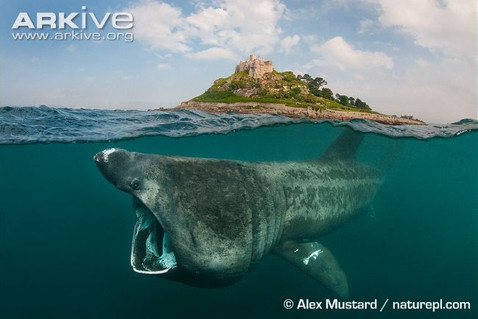Finn Friday: Basking Shark
- Alyssa Allen

- Mar 12, 2021
- 3 min read
Hello my fellow curious critters and welcome back to The Friendly Neighborhood Shark Lady! For today’s fin-tastic Finn Friday we are going to be learning all about the second-largest fish that calls our oceans home, the Basking shark. Reaching lengths of 46+ feet and weighing in at around 6 tons, only the Whale shark beats these guys in terms of size. So let’s throw on our wetsuits, dive in, and learn all about the behemoth Basking shark.
Where do they live?
Basking sharks can be found all over the world in warm to cold waters but are not found in the tropics. They have been spotted anywhere from close to the coast to out in the open ocean. Basking sharks are highly migratory and don’t tend to stay in the same place for more than a couple of months. This has made it a bit difficult for scientists to study them.

How long do they live?
Scientists believe that Basking sharks live to be around 50 or so years old. Females reach sexual maturity at 12-16 years old and give live birth to what scientists believe are the largest babies of all fishes. Basking sharks give birth to pups that range in length from 4.5-6 feet (1.4-2 meters). They only give birth to a few pups at a time and gestation takes around 3 years.
What do they eat?
Like their friends the Whale sharks, Basking sharks are filter feeders. They feed on zooplankton, fish eggs, larvae, and small crustaceans. Unlike Whale sharks, Basking sharks do not use suction to help bring in more water to filter out food. They rely solely on the passive flow of water over their gill rakers as they swim through the water with their mouths open. Even without the help of suction, Basking sharks filter over 2,000 pounds (900 kilograms) of water every hour!
What do they like to do?
Basking sharks are not typically solitary creatures, but the sizes of their groups can drastically vary from anywhere between two individuals to over 100. Scientists believe that males and females only hang out together when it is time to mate. It is also believed that pregnant females sequester themselves away from the main groups as they are rarely seen. Basking sharks are very docile and do not pose a threat to humans. They are very tolerant of boats, divers, and scientists when they are being studied. Basking sharks have been known to attack boats on occasion when they’ve been harpooned by fishermen, but you can’t really blame them for that.
Ok, now for something I learned today that absolutely blew my mind. Sharks’ skin is covered in something called dermal denticles. Dermal denticles are like little scales and help sharks in a couple of ways. One, they make the shark’s skin very tough and help protect them. Two, they help make sharks more hydrodynamic by reducing the amount of drag, or friction, when they swim through the water. If you have ever been to an aquarium where they let you touch sharks, you know they tend to feel a bit rough like sandpaper. Well, Basking sharks’ skin is so rough that it has actually been known to cause damage to divers and scientists if they aren’t careful when interacting with them.
Conservation Status:
According to the IUCN Red List, Basking sharks are endangered with a decreasing population. Many factors have contributed to the dramatic decline in their population number, but as with most species, overfishing is one of the biggest. Because Basking sharks are a slow-growing species, have a long gestation period, and give birth to few young at a time, it is very difficult for their populations to recover once they have been depleted. Basking sharks are highly valued in Asian markets for their fins, meat, and liver oils. Some governments have now put protections in place to try and help save these amazing creatures, but there is still a lot of work to be done.
Thank you so much for coming and learning with me today! Don’t you find it funny that the two largest fish in the world eat some of the smallest animals in the world? I have always thought it was crazy that such a large animal would survive on tiny little zooplankton and fish eggs. Nature never ceases to amaze me. I hope I will see you all back here soon for more science fun!
Sources:









Comments